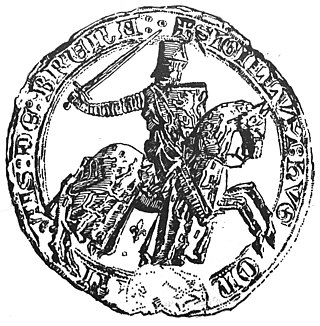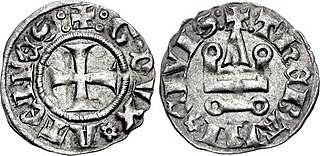
Walter V of Brienne was Duke of Athens from 1308 until his death. Being the only son of Hugh of Brienne and Isabella de la Roche, Walter was the heir to large estates in France, the Kingdom of Naples, and the Peloponnese. He was held in custody in the Sicilian castle of Augusta between 1287 and 1296 or 1297 to secure the payment of his father's ransom to the Aragonese admiral Roger of Lauria. When his father died fighting against Lauria in 1296, Walter inherited the County of Brienne in France, and the counties of Lecce and Conversano in southern Italy. He was released, but he was captured during a Neapolitan invasion of Sicily in 1299. His second captivity lasted until the Treaty of Caltabellotta in 1302.

The House of Ibelin was a noble family in the Crusader Kingdom of Jerusalem in the 12th century. They rose from humble beginnings to become one of the most important families in the kingdom, holding various high offices and with extensive holdings in the Holy Land and Cyprus. The family disappeared after the fall of the Kingdom of Cyprus in the 15th century.
Isabella of Brienne (1306–1360) was suo jure Countess of Lecce and Conversano, claimant to the Duchy of Athens and Kingdom of Jerusalem, etc.

Hugh, Count of Brienne and Lecce was the second surviving son of Count Walter IV of Brienne and Marie de Lusignan of Cyprus.

Louis of Enghien titular Duke of Athens, Count of Brienne and Lord of Enghien in 1381–1394, Count of Conversano in 1356–1394.

The Villehardouin family was a noble dynasty that originated in Villehardouin, a former commune of the Aube department, now part of Val-d'Auzon, France. It is most notable as the ruling house of the Principality of Achaea, a Frankish crusader state in the Peloponnese peninsula of Greece, between 1209 and 1278, when possession passed to the Angevin Kings of Naples.
Guy I de la Roche (1205–1263) was the Duke of Athens, the son and successor of the first duke Othon. After the conquest of Thebes, Othon gave half the city in lordship to Guy.

Guy II de la Roche, also known as Guyot or Guidotto, was the Duke of Athens from 1287, the last duke of his family. He succeeded as a minor on the death of his father, William I, at a time when the duchy of Athens had exceeded the Principality of Achaea in wealth, power, and importance.
Nicholas III of Saint-Omer was one of the most powerful and influential lords of Frankish Greece. He was hereditary Marshal of the Principality of Achaea, lord of one third of Akova and of one half of Thebes. He also served on three occasions as bailli of the Principality of Achaea.
Joanna of Châtillon or Joan, French: Jeanne; was the wife of Walter V of Brienne (1305). She was Duchess of Athens by marriage (1308–1311). She was the daughter of Gaucher V de Châtillon, Constable of France and Isabelle de Dreux. Her paternal grandparents were Gaucher IV de Châtillon and Isabelle de Villehardouin. Her maternal grandparents were Robert de Dreux, Viscount of Chateaudun and Isabelle de Villebéon.
Eschive d'Ibelin (1253–1312) was suo jure Lady of Beirut in 1282–1312. She was the daughter of John II of Beirut, lord of Beirut, and of Alice de la Roche, and a member of the influential Ibelin family.

Alice de la Roche was a Latin noblewoman who ruled the Lordship of Beirut in the Kingdom of Jerusalem as regent and a claimant to the Duchy of Athens. She was a daughter of Duke Guy I de la Roche. Alice was regent of Beirut for her daughter, Lady Isabella, while Isabella was the queen consort of Cyprus.
Philippa of Champagne was the third daughter of Queen Isabella I of Jerusalem and Count Henry II of Champagne. She was the wife of Erard de Brienne-Ramerupt, who encouraged her in 1216 to claim the county of Champagne which belonged to her cousin Theobald IV, who was still a minor. This provoked the conflict with Theobald's mother, the Regent, Blanche of Navarre, which erupted into open warfare, and came to be known as the Champagne War of Succession. Blanche's son Theobald, who had the support of King Philip II of France, Frederick II, Holy Roman Emperor, and Eudes III of Burgundy, eventually emerged the victor. Philippa renounced her claim in April 1222, but Theobald was constrained to pay Erard and Philippa a large monetary settlement for his rights to the county.
Mary of Lusignan, was the wife of Count Walter IV of Brienne and Countess of Brienne from the time of her marriage in 1233 to her husband's death while on Crusade in 1244. Mary's parents were King Hugh I of Cyprus and Alice of Champagne, making her a maternal granddaughter of Queen Isabella I of Jerusalem. Her two surviving sons were John, Count of Brienne, and Hugh of Brienne.

The Barony of Karytaina or of Skorta was a medieval Frankish fiefdom of the Principality of Achaea, located in the Peloponnese peninsula in Greece, centred on the town of Karytaina in the mountainous region known as Skorta.
Geoffrey of Briel, in older literature Geoffrey of Bruyères, was a French knight and the third lord of the Barony of Karytaina in the Principality of Achaea, in Frankish Greece. He led a colourful and turbulent life, narrated in detail in the Chronicle of the Morea. Accounted the finest knight in the Principality, he fought in the wars against the Byzantine Greeks, was captured in the Battle of Pelagonia in 1259, and was sent back to Achaea bearing the Byzantine terms in 1261. Geoffrey was twice deprived of his barony, once for rebelling against his uncle, the Prince of Achaea William II of Villehardouin, and then for abandoning the Principality without leave in order to spend time with a mistress, the wife of one of his feudatories, in Italy. He was pardoned both times, but henceforth held his title as a gift of the Prince. He died childless in 1275, and the Barony of Karytaina was split up.
Hugh of Briel, in older literature Hugh of Bruyères, was a French knight and the second lord of the Barony of Karytaina in the Principality of Achaea, in Frankish Greece.
Renaud of Briel, in older literature Renaud of Bruyères, was a French knight and the first lord of the Barony of Karytaina in the Principality of Achaea, in Frankish Greece.
Helena Angelina Komnene was a daughter of the Greek sebastokrator John I Doukas, ruler of Thessaly in ca. 1268–1289, and a Greek princess of Aromanian origin, known only by her monastic name, Hypomone.

The de la Roche family was a French noble family named for La Roche-sur-l'Ognon in Burgundy, France that founded the Duchy of Athens 1204 and held it for just over a century.









